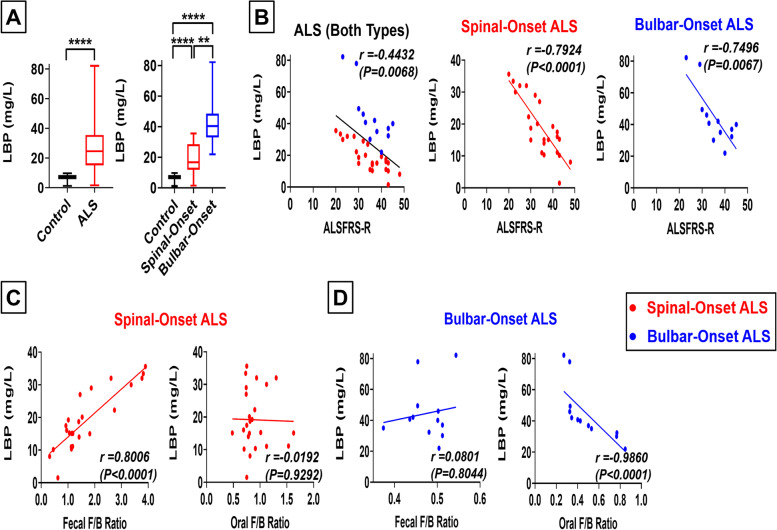Fig. 6.
For Spinal-Onset ALS, Gut-Dysbiosis May Drive Microbial Translocation to Blood, Leading to Increased Disease Severity, whereas for Bulbar-Onset ALS, Oral-Dysbiosis May Drive Microbial Translocation to Blood, Leading to Increased Disease Severity. A Blood lipopolysaccharide-binding protein (LBP) levels in mg/L as a marker for microbial translocation to the blood. Results represent both ALS patients (spinal- and bulbar-onset ALS patients combined) or spinal- and bulbar-onset ALS patients quantified separately. Both spinal- and bulbar-onset ALS patients displayed significant increases in blood LBP levels, with bulbar-onset ALS patients showing significantly higher levels than spinal-onset ALS patients. B Linear regression analysis comparing blood LBP levels and ALSFRS-R score for all ALS patients combined (left), spinal-onset ALS patients only (middle), and bulbar-onset ALS patients only (right). Spinal-onset ALS patients shown in red, bulbar-onset ALS patients shown in blue. In both spinal- and bulbar-onset ALS patients, higher blood LBP levels (greater microbial translocation to the blood) were strongly associated with lower ALSFRS-R score (greater ALS severity). C Linear regression analyses comparing fecal F/B ratio and blood LBP levels (left) and oral F/B ratio and blood LBP levels (right) in spinal-onset ALS patients. In spinal-onset ALS patients, fecal F/B ratio showed strong correlations with blood LBP levels, but oral F/B ratio showed poor correlations with blood LBP levels. In spinal-onset ALS patients, higher fecal F/B ratio (greater gut-dysbiosis) was strongly associated with greater blood LBP levels (greater microbial translocation to the blood). D Linear regression analyses comparing fecal F/B ratio and blood LBP levels (left) and oral F/B ratio and blood LBP levels (right) in bulbar-onset ALS patients. In bulbar-onset ALS patients, oral F/B ratio showed strong correlations with blood LBP levels, but fecal F/B ratio showed poor correlations with blood LBP levels. In bulbar-onset ALS patients, lower oral F/B ratio (greater oral-dysbiosis) was strongly associated with greater blood LBP levels (greater microbial translocation to the blood). Statistics: In panel A, contrasts between control and ALS patients (combined) utilized Mann–Whitney test, while contrasts between control, spinal-onset ALS, and bulbar-onset ALS utilized Kruskal–Wallis test with Dunn’s post-hoc test. Values represent sample median with interquartile range. For panels B-D, statistical significance was established using linear regression analysis and Spearman’s correlation coefficient (r) test. *P < 0.05, **P < 0.01, ***P < 0.001, ****P < 0.0001

